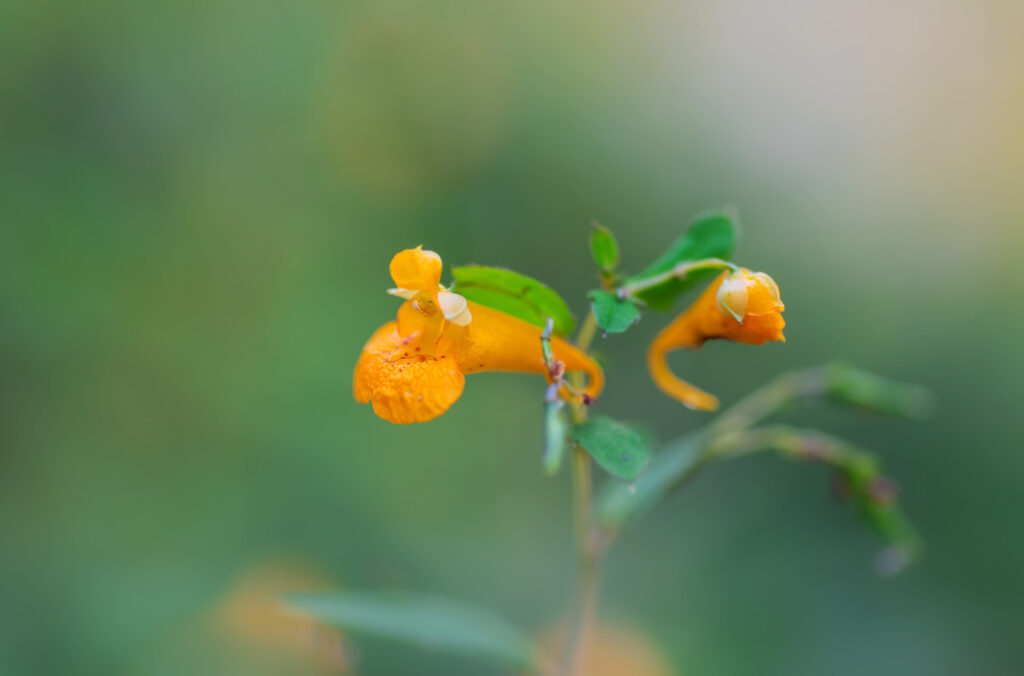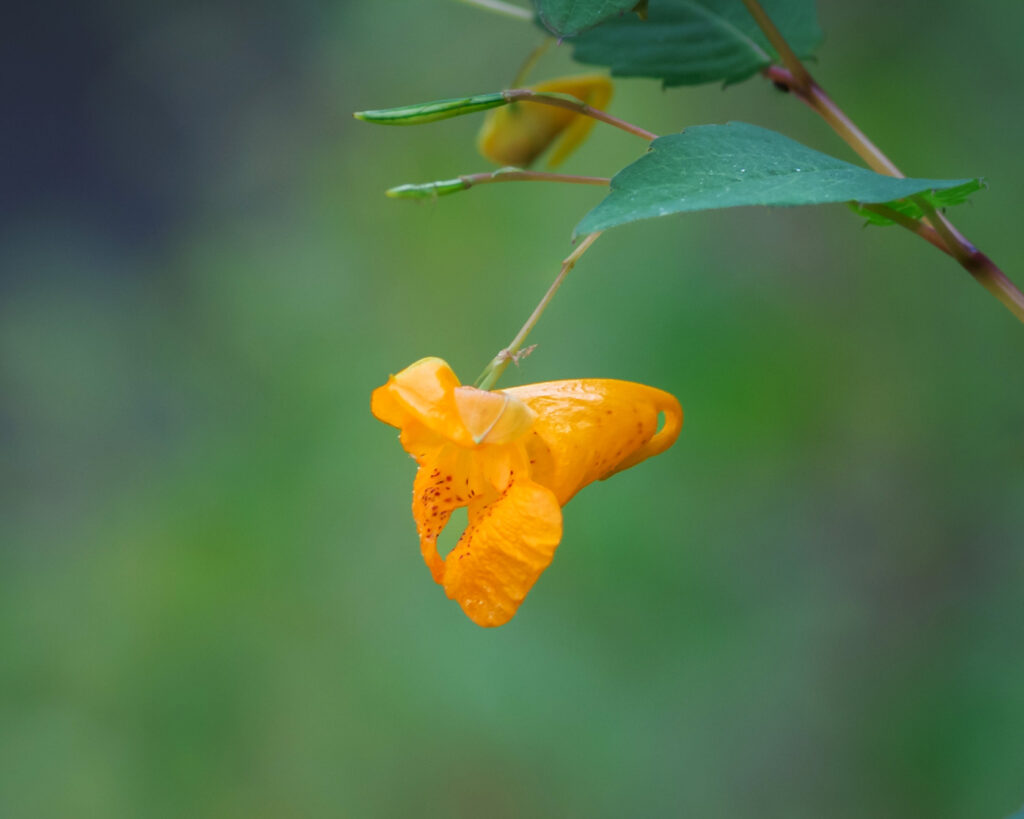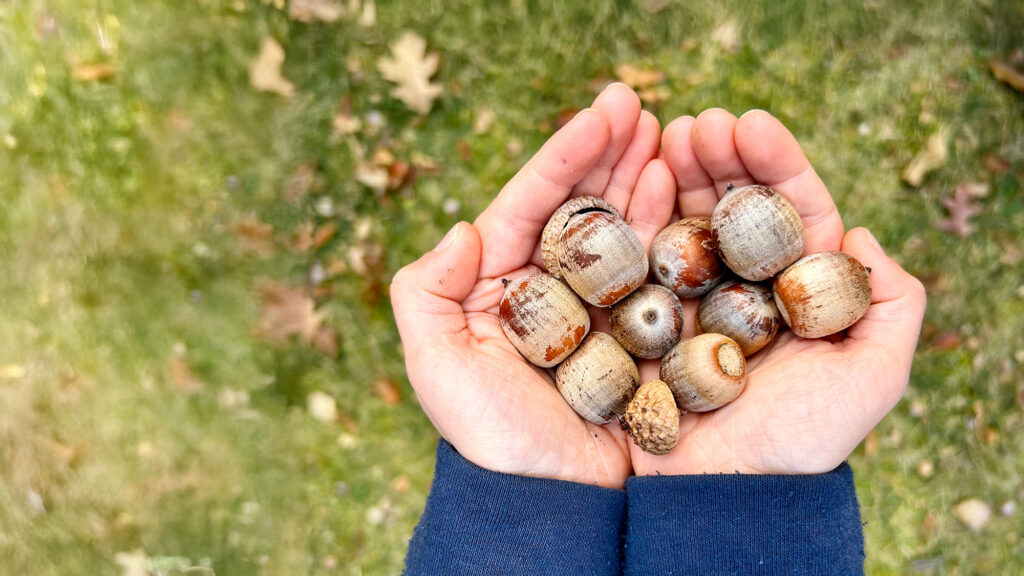
Jewelweed: A Hidden Gem for Pollinators in Your Garden
“Oh, you have touch-me-nots in your garden!” said a recent visitor to our house. “I should say so!” I answered, hearing only the “touch-me-not”. Okay, maybe I only thought that but I must have had a funny expression on my face because she laughed and explained that “touch-me-nots” was the common name where she had grown up for the weeds I knew as “jewelweeds”, which were currently taking over one of our garden beds. Our visitor explained that the name “touch-me-not” came from the way the seedpods burst upon contact and promptly demonstrated the action to us. I was surprised, I had never seen that happen in the four years I had been living and tending to that garden bed. Maybe I just never noticed. In fact, I was feeling a little guilty remembering the first year we had lived in this house and how I had pulled up all those pretty little flowers, thinking of them as weeds (I mean, it’s in their name!). It was in the second year that I noticed how many bees visited the jewelweed’s delicate orange flowers and decided not to pull them all out but leave a little corner for the local pollinators. A little corner that had now become half the bed since I have done literally no weeding this year.
What are weeds but perfectly nice plants in the wrong spots? (Well, I am going to exempt plants that poke, stick, slime, dust or otherwise injure us!) I know when we think of garden and flower beds, we often envision neatly arranged flowers, shrubs, and ornamental grasses, spaced out with mulch between them, everything neat and tidy. That’s the picture in my head anyway. In this vision, weeds are unwelcome intruders we quickly pull up (some of us, anyway…). Yet, some of the prettiest flowers and leaves are on plants considered “weeds”. Interestingly, weeds are often native species, which raises questions about the way we historically devalue native flora and fauna in favor of ones we have imported. But that is a blog post for another time! For now, let’s focus on the humble jewelweed (Impatiens capensis), one of those misunderstood weed species many see as a nuisance but which is actually a vibrant supporter of pollinators, playing a key role in our local ecosystems.
What is Jewelweed?

Jewelweed is a native plant that thrives in moist, shady areas across North America and Canada. It is an annual, growing from seed, blooming, and dying off in one season. It typically blooms in late summer to early fall, displaying delicate, trumpet-shaped orange or yellow flowers. These blooms, often speckled with dark orange or red, act as a beacon to pollinators, particularly bumblebees, honeybees, and hummingbirds, which rely on their nectar. The first year I didn’t look too closely at the flowers, other than to notice how bright they were in the shady bed in which they had taken root — right before I pulled them. The second year, I gained a new appreciation for them as I photographed their beautiful colors and patterns through my macro lens, seeing them in a new way.
Jewelweed’s flowers are not showy, but small and delicate. The stalks are soft and flexible, bending easily with any breeze. The oval leaves alternate on the stem and have a jagged edging. The seed pods of “touch-me-not” fame contain the plant’s fruit in a tiny but long pod; if jostled, five valves will shoot the pod out in a seeding process called “explosive dehiscence”, which is a pretty interesting adaptation for spreading seeds! Careful, though, the seeds can be toxic.

While jewelweed’s pretty orange flowers rely on cross-fertilization, jewelweed also produces less noticeable flowers that never open (which doesn’t follow my usual idea of flowers). These “cleistogamous” flowers don’t need any help from insects or birds to fertilize, they can do it themselves, producing seeds without pollen from other plants. The cleistogamous flowers seem to me to be a back up system of sorts, a fascinating evolved mechanism for ensuring survival. Even if the plants are not as robust as cross-fertilized plants, their seeds are less costly for the parent plant to produce and may be enhance survival when resources are scarce or there are few other jewelweed plants for cross-fertilization.
There are several different species of jewelweed with different (but sometimes the same) common names, such as Impatiens capensis, pictured here, with brightly colored orange blooms, which is also called orange balsam, orange jewelweed, spotted jewelweed, and spotted touch-me-not. A related species, Impatiens pallida, has larger yellow flowers of a similar shape and goes by similar names such as yellow jewelweed and touch-me-not.
Interestingly, mashed jewelweed has been shown to help reduce itching from poison ivy rash and the stems may have fungicidal properties that could help treat conditions such as athlete’s foot. [Be sure to consult a medical professional before using jewelweed to treat any conditions.]

Jewelweed is easy to overlook, growing along the edges of gardens or in wild, untamed areas, and so usually dismissed as a weed. However, it is a native plant with ecological benefits, especially for supporting pollinator species in decline.
Jewelweed as a Pollinator Haven
Pollinators, including bees, butterflies, and hummingbirds, are essential for maintaining biodiversity and aiding in the production of fruits, vegetables, and flowers. As many of these pollinators struggle due to habitat loss, chemical use, and climate change, jewelweed provides a crucial nectar source at a time when other flowers are starting to fade.

Hummingbirds are particularly drawn to jewelweed’s bright orange blooms. Just this summer, I several times surprised a hummingbird as I exited the house by the jewelweed, the first time being a mutual surprise that gave me quite a startle. I didn’t know jewelweed would attract hummingbirds but looking at the shape of their bright orange flowers, the way the five petals curve to make a short tube to a pocket of nectar, I see how the flower’s tubular shape make it an ideal fit for their long beaks.
Unlike hummingbirds, bumblebees, butterflies, and other insects with long tongues are able to land on the flower to access the nectar, performing an essential pollination service in the process when they brush against the flower’s pollen and leave some from other plants behind. Honeybees also frequent jewelweed. I always enjoy watching the busy bees fly to each and every jewelweed flower, marveling about how they remember where they already have been and where they need to go.

By allowing jewelweed to grow in your garden, particularly in spots that might otherwise go unused or have been left to the wild, you’re creating a mini-refuge for pollinators, especially in urban or suburban areas where natural food sources may be sparse.
Benefits to Your Garden
Aside from supporting pollinators, jewelweed can offer several benefits to your garden:

- Soil Protection: Jewelweed often grows in areas that are moist and prone to erosion. Its root system helps stabilize the soil, reducing the likelihood of water runoff.
- Natural Pest Control: Jewelweed is thought to attract aphid-eating insects, providing a natural form of pest control for nearby plants. I think this might be because the jewelweed plant attracts aphids – there’s actually an aphid species called green jewelweed aphid (Macrosiphum impatientis)! So no doubt, aphid-eating insects would be attracted to the aphids on the jewelweed. I am looking into this and will update once I find more information.
- Fungal Inhibitor: Some studies suggest that jewelweed contains compounds that may inhibit the spread of certain fungal infections in plants — and people! While more research is needed, this adds another reason to consider its role in the garden ecosystem.
How to Incorporate Jewelweed in Your Garden
If you’re looking to add jewelweed to your garden, there are several ways to do so without letting it overtake more manicured areas.
- Wild Corners: Set aside a section of your garden, especially in a moist, shaded area, where you can let jewelweed and other wild native plants grow freely. This can serve as a mini-habitat for pollinators and wildlife.
- Mixed Beds: Jewelweed can be integrated into more formal garden beds, especially in areas where other flowers might struggle. Just be mindful of its tendency to spread, and consider controlling its growth by regularly deadheading or removing seed pods.
- Borders Near Water: Jewelweed thrives in moist conditions, making it a great candidate for areas near a pond, rain garden, or even a low-lying part of your yard that tends to stay damp.
- Just don’t weed: my current method, although I don’t recommend it as jewelweed is pretty hardy and prolific so it can quickly take over a bed without regular tending.
Supporting Pollinators Beyond Jewelweed
While jewelweed is an excellent plant for pollinators, there are many other ways you can create a pollinator-friendly garden:
- Diverse Plantings: Include a variety of native plants that bloom at different times throughout the year. This ensures that pollinators have access to nectar and pollen from spring to fall. Examples of other pollinator-friendly plants include milkweed (for monarch butterflies), coneflowers, and bee balm.
- Avoid Pesticides: Many pesticides and herbicides are harmful to pollinators. Opt for organic gardening methods or targeted treatments that minimize harm to beneficial insects.
- Provide Water Sources: Pollinators need water just like any other animal. Place shallow dishes of water in your garden or create a small water feature that allows bees and butterflies to drink safely.
- Offer Shelter: Pollinators need safe spaces to rest and nest. You can provide shelter by leaving dead wood or brush piles in corners of your yard, or by installing bee hotels to support native solitary bees.
Changing the Way We See Weeds
I’m working on changing my mindset around some plants I used to think of as weeds, making space for them in our flower beds, the edges of the lawn, along the stone wall and driveway, and elsewhere. It’s been fun to what comes up and how it changes from spring to fall. Reframing the concept of weeds can lead to a healthier garden and ecosystem. While certain invasive species undoubtedly need to be controlled, native plants like jewelweed provide significant benefits that go beyond the aesthetic. They offer critical food sources to pollinators, help manage soil health, and can even contribute to pest management in the garden.
So, the next time you see a patch of jewelweed, consider giving it space to grow. By embracing these “weeds,” you’re supporting the pollinators that make your garden thrive — and creating a more sustainable, balanced environment for all.
What do you think about keeping jewelweed in your garden? Have you allowed it or other ‘weeds’ to stay in your gardens? Please share your thoughts or experiences with pollinator-friendly gardening!





